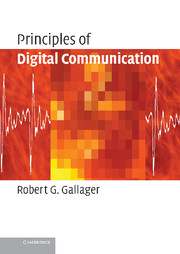Book contents
- Frontmatter
- Contents
- Preface
- Acknowledgements
- 1 Introduction to digital communication
- 2 Coding for discrete sources
- 3 Quantization
- 4 Source and channel waveforms
- 5 Vector spaces and signal space
- 6 Channels, modulation, and demodulation
- 7 Random processes and noise
- 8 Detection, coding, and decoding
- 9 Wireless digital communication
- References
- Index
8 - Detection, coding, and decoding
Published online by Cambridge University Press: 05 June 2012
- Frontmatter
- Contents
- Preface
- Acknowledgements
- 1 Introduction to digital communication
- 2 Coding for discrete sources
- 3 Quantization
- 4 Source and channel waveforms
- 5 Vector spaces and signal space
- 6 Channels, modulation, and demodulation
- 7 Random processes and noise
- 8 Detection, coding, and decoding
- 9 Wireless digital communication
- References
- Index
Summary
Introduction
Chapter 7 showed how to characterize noise as a random process. This chapter uses that characterization to retrieve the signal from the noise-corrupted received waveform. As one might guess, this is not possible without occasional errors when the noise is unusually large. The objective is to retrieve the data while minimizing the effect of these errors. This process of retrieving data from a noise-corrupted version is known as detection.
Detection, decision making, hypothesis testing, and decoding are synonyms. The word detection refers to the effort to detect whether some phenomenon is present or not on the basis of observations. For example, a radar system uses observations to detect whether or not a target is present; a quality control system attempts to detect whether a unit is defective; a medical test detects whether a given disease is present. The meaning of detection has been extended in the digital communication field from a yes/no decision to a decision at the receiver between a finite set of possible transmitted signals. Such a decision between a set of possible transmitted signals is also called decoding, but here the possible set is usually regarded as the set of codewords in a code rather than the set of signals in a signal set. Decision making is, again, the process of deciding between a number of mutually exclusive alternatives.
- Type
- Chapter
- Information
- Principles of Digital Communication , pp. 268 - 329Publisher: Cambridge University PressPrint publication year: 2008
- 1
- Cited by



